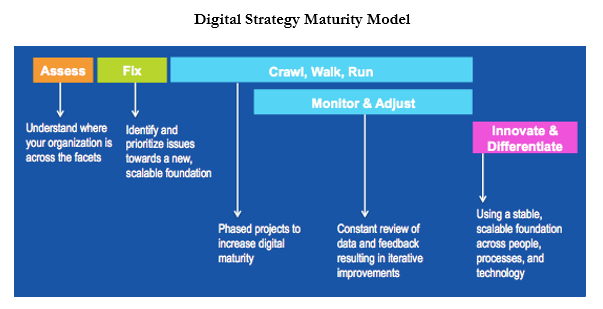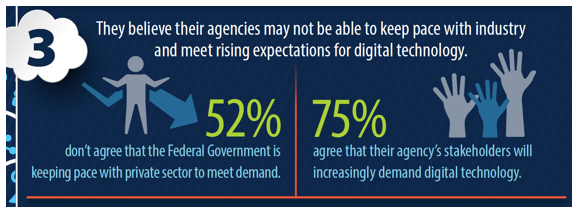Jeremy Vanderlan, ICF International
As leaders at federal agencies come to grips with the tools of the digital age, they must develop an understanding of the right digital investments and initiatives to meet the expectations of their employees and the publics they serve. Catching up to the pace of this environment is a bit like boarding a moving train—you must build some momentum before you can jump on and move forward.
To gauge leaders’ attitudes and beliefs about how government is adopting, applying, and leveraging technology, ICF International and the National Academy of Public Administration (NAPA) administered the inaugural Federal Leaders Digital Insight Study to 510 senior-level civil servants. Survey results shed light on perceptions about the importance of embracing digital technology and possible barriers to fully realizing its potential.
Assessing Digital Maturity
Before boarding the moving train of digital transformation, leaders must understand their organization’s current state. Commercial models assess digital readiness across multiple facets such as technology resources, data strategy, content development, channel strategy, and even human resources policy. This assessment then can serve to develop a digital strategy maturity model or matrix. The resulting model should be viewed as a continuum, with various states of readiness and activity.

Depending on where an organization falls in this continuum, concrete actions can be taken to move up to a more mature and innovative approach to digital. Because of the breadth of federal programs within agencies, each agency likely could see projects scattered across this continuum. Some agencies are already mature digital leaders. Others need a digital reboot. By using a common framework to evaluate their agency’s programs, digital leaders could quickly understand the needs and capabilities of these programs.
Although commonalities exist between commercial and federal digital strategy considerations, a number of facets are distinctive to the federal environment. Regulations, agency culture, and mission all influence federal digital strategy in an exceptional way. Analysis of the ICF/NAPA Digital Insight Study responses revealed these factors: Risk tolerance, appetite for innovation, and need for collaboration, as described below.
1. Risk Tolerance
Innovation in digital, especially to keep pace with commercial entities, requires the ability to take risks and test hypotheses. Seventy-five percent of survey (75 percent) respondents expect that their stakeholders will increasingly demand digital engagement. Yet, most say their agency is not keeping pace with the private sector.

Understanding that not everything is going to work and learning from that failure is a core concept behind much of what passes for success in Silicon Valley. This tolerance for risk is a difficult sell in the federal environment. The price for failure is not just a monetary loss or a failed business venture. Outcomes could be appearing before Congress, paying fines, or even serving time.
Prison might sound extreme but not necessarily, according to a recent article on the Federal Times website [1]. U.S. Department of Commerce Chief Information Officer (CIO) Steve Cooper comments on private and public cloud computing infrastructure:
“If you are responsible in any way, shape or form for a breach of Census data: 10 years in jail, $250,000 fine,” he said. “I’ve got news for you: I’m not signing off on anything other than a private cloud when it comes to Census.”
Public cloud computing has been cited as a critical component of the innovation infrastructure needed to bring government IT up to commercial standards. For many agencies, such computing is a nonstarter. The policy has not kept pace with the technology.
In an environment where failure could mean severe penalties and even public harm, the need to identify the right amount of risk and to adjust policy to enable and encourage those risks is paramount. Agencies must figure out that balance to be well-positioned for digital innovation.
2. Appetite for Innovation
The Digital Insight Study showed that only 15 percent of leaders believe their agency is making new technology available to its employees at the same pace as the private sector. Many more (80 percent) say job-related online information and transaction services should be available any time and on any device. The high demand for digital services within the federal workforce reflects the digital transformation in the way we now live. Findings from the survey indicate a strong desire to enhance productivity with the right tools.

For mission-focused federal workers, digital services are a means to an end—but these leaders are not digital experts. They need guidance and a picture of what is possible, case studies of what has worked, and cautionary tales of what has failed.
Reflecting the change in thought that may be required to embrace innovation and move forward on the digital maturity continuum, former U.S. CIO Steve VanRoekel, cited the need for agencies to “#failfast versus #failbig”:

This statement reflects a required change in how digital services are procured, built, and released to the public. The #failbig hashtag speaks directly to some of the notable federal IT failures like healthcare.gov that suffered from the “monolithic” aspects, VanRoekel noted.
The new CIO playbook released by the U.S. Digital Service illustrates a philosophy that matches this new approach. The book provides a good reference framework with a nice checklist of action items but lacks an implementation step. Programs and agencies still need to distill this playbook to meet their unique missions and audiences.
3. Need for Collaboration
To maximize government investment in technology and minimize the possibility of failure, leaders must be able to look across projects, job functions, and even agency boundaries. When asked which tools have the greatest impact on workplace performance, federal leaders named these top three:
- Agency-provided smartphones
- Secure remote access to work systems
- Agency-provided collaboration and team online sharing tools
Part of digital innovation is doing more with less. Unfortunately, many digital projects are derailed by blown budgets or incomplete and broken programs. Collaboration between technical teams and the programs they serve must be nurtured throughout the life of the project. An agile, iterative approach ensures shorter feedback loops between developers and program staff members who know what they are seeking to accomplish. Tight, agile teams should be cross-disciplinary and comprise design, technical, communications, and program staff.
“In today’s world, if you are not part of the technical conversation from its beginning, you’re wasting labor hours and time.” —Miguel Gomez, AIDS.gov http://responsivewebdesign.com/podcast/aids-gov.html
About the Author
Jeremy Vanderlan is the Mobile Practice Lead for the Digital Strategy team at ICF. As the resident expert on mobile platform development he guides strategy and technical implementation on mobile and interactive projects—capitalizing on the significant cultural shift towards mobility—to make projects available anytime, anywhere, on any device.
He has worked with clients like AIDS.gov in developing one of the first responsively-designed websites in the Federal government, and has contributed to the Mobile Community of Practice at GSA by speaking on mobile application development, performance testing, and mobile user experience. He has also spoken at events like SXSW Interactive, Mobile Health 2011, and the mHealth Summit.
About ICF International
ICF International (NASDAQ:ICFI) provides professional services and technology solutions that deliver beneficial impact in areas critical to the world’s future. ICF is fluent in the language of change, whether driven by markets, technology, or policy. Since 1969, we have combined a passion for our work with deep industry expertise to tackle our clients’ most important challenges. We partner with clients around the globe—advising, executing, innovating—to help them define and achieve success. Our more than 5,000 employees serve government and commercial clients from more than 70 offices worldwide. ICF’s website is www.icfi.com.
[1] Federal Times. Hashmi: Private clouds aren’t really ‘cloud.’ Available at http://www.federaltimes.com/story/government/it/cloud/2015/02/12/private-clouds-arent-cloud/23298545/; retrieved February 2, 2015.




Leave a Reply
You must be logged in to post a comment.